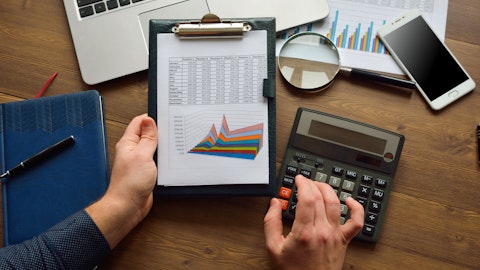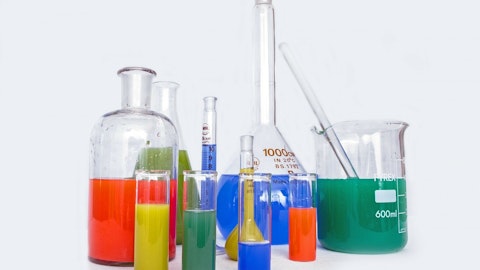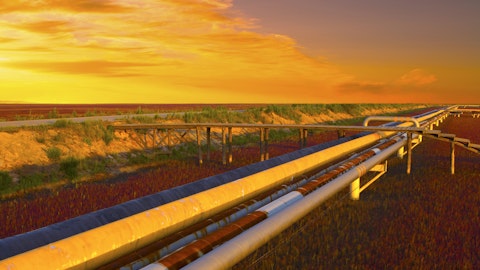Vermilion Energy Inc. (NYSE:VET) Q4 2022 Earnings Call Transcript March 9, 2023
Operator: Please standby. We’re about to begin. Good morning. My name is Jess, and I will be your conference operator today. At this time, I would like to welcome everyone to the Vermilion Energy Q4 Conference Call. All lines have been placed on mute to prevent any background noise. After the speakers’ remarks, there will be a question-and-answer session. Mr. Dion Hatcher, you may begin your conference.
Dion Hatcher: Thank you, Jess. Well, good morning, ladies and gentlemen. Thank you for joining us today. I’m Dion Hatcher, President and CEO of Vermilion Energy. With me today are Lars Glemser, Vice President and CFO; Darcy Kerwin, Vice President, International and HSE; Bryce Kremnica, Vice President, North America; Jenson Tan, Vice President, Business Development; and Kyle Preston, Vice President of Investor Relations. We’ll be referencing a PowerPoint presentation to discuss the Q4 full year 2022 results. Presentation can be found on our website under Invest with Us and Events and Presentations. Please refer to our advisory and forward-looking statements at the end of the presentation, it describes the forward-looking information, non-GAAP measures and oil and gas terms used today and outline the risk factors and assumptions relevant to this discussion.
In 2022, we delivered on our strategic priorities and continue to reposition Vermilion for long-term success. We remain focused on financial discipline and reduced net debt by another $300 million. We benefited from strong European gas prices as a result of our international diversified asset base, we advanced the core of acquisition to significantly enhance our Euro gas exposure, which is planned to close on March 31st of this year, and we completed the strategic acquisition of Leucrotta Exploration, marking Vermilion’s entry into the prolific Montney resource play, which has significantly increased the depth and quality of our drilling inventory. Looking at our financial results, Vermilion generated record fund flows of $1.6 billion and record free cash flow of $1.1 billion, representing a year-over-year increase of 78% and 99%, respectively.
These results were achieved despite a $406 million of realized hedging losses and $223 million of temporary European windfall taxes. This free cash flow allows us to fund over $500 million of strategic acquisitions, reduced net debt by over $300 million and returned over $100 million to our shareholders through dividends and share buybacks. We launched a return of capital framework in 2022, which included a reinstated quarterly dividend in Q1 and the commencement of a share buyback program in Q3, returning a total of 11% of our free cash flow during the year. We exited the year with net debt of $1.3 billion and a resulting net debt to fund flow ratio of 0.8 times, which is the lowest leverage in over 10 years. In the fourth quarter of 2022, we reported $284 million of fund flows.
However, it’s important to note that this includes the full year impact of the temporary EU windfall taxes. The windfall tax was enacted in Q4 2022 and was applied retroactively. So the full amount is reflected in our Q4 results. Excluding the windfall tax, Q4 fund flow would have been $507 million, which is in line with the prior quarter. Free cash flow in Q4 was $150 million — $115 million, including the impact of the windfall taxes or $338 million, excluding the windfall tax. Production for the quarter was 85,450 BOE per day, which is up slightly from the prior quarter. Production in Q4 was impacted by unplanned downtime in Australia cold weather and third-party downtime in North America and the delayed start-up of our six-well Montney pad in Alberta.
Production from our North American assets averaged 58,499 BOEs per day, which is an increase of 2% from the prior quarter, mainly due to new production for our Montney assets in Canada and a full quarter contribution of our US drilling program. Our primary focus in Q4 was tying in their first six well, Alberta Montney pad at Mika. As you can recall, this is a pad that we took over drilling operations from Leucrotta following the close of the acquisition at the end of May. The wells were brought on stream at the end of November and cleaned up during December, resulting in Montney production of approximately 7,500 BOEs a day in December. In Q1, we’ve drilled and completed a follow-up three-well Alberta pads and will bring those wells on production in early Q2.
In January, the British Columbia government announced agreements with the Blueberry River First Nations and other Treaty 8 First Nations, outlining guidelines pertaining to future resource development in the region. We view this as a positive development. Our BC assets are located outside of Blueberry River First Nations’ High Value Areas and are on predominantly private freehold land, which we will — and we continue to receive permits. We believe this will help facilitate the timely approval of future permits required to expand our Montney development in British Columbia. Alberta inventory provided us with an operational buffer pending Blueberry River First Nations resolution. So we will continue to maintain our production at capacity in Alberta for efficiency purposes, we are now in a position to pivot back to the hard fall of the inventory in BC.
In Q1, we finished drilling on a two-well BC pad, and we’re currently preparing for completion operations. Production from our International assets averaged 26,953 BOEs per, which is down slightly from the prior quarter, primarily due to natural decline in Netherlands and Germany, as well as lower-than-anticipated production in Australia due to unplanned downtime. We drilled one oil well in Germany, which was brought on production in Q1 and drove one gross 0.5 net gas well in the Netherlands, which encountered a 19-meter gas column. We expect to bring this new Netherlands well on production in the first half of ’23. In Australia, production from the Wandoo field was temporary shut-in during December to repair a minor leak. Upon further inspection, we’ve identified additional maintenance and as a precautionary measure to ensure continued safe operations of the facility, we elected to complete a detailed inspection of the entire facility and conduct all necessary repairs at this time.
This will result in production being off-line for the entire first quarter. However, we expect this maintenance activity to help minimize future downtime. The repairs themselves are minor in nature, but due to the complexity of working on an offshore platform, it takes several months to safely complete the work. Looking at our 2022 reserves, we increased our proved plus probable reserves of 9% to 523 million BOE, primarily driven by the Leucrotta acquisition and positive economic revisions. The after-tax net present value of our proved plus probable reserves discounted at 10%, increased 36% from the prior year to $8.9 billion or $54 per share, with PDP reserves making up more than 50% of this value, including acquisitions, we replaced 234% of production on a proved plus probable basis, at an FD&A cost, including future development costs of $19.22 per BOE, resulting in a total proved plus probable FD&A operating recycle ratio of 4.4 times.
On a proved plus probable reserve life index increased by 9% in 2022 to 16.8 years, reflecting our continuing focus on enhancing the depth of our drilling inventory. For the past decade, we have successfully increased our reserve life index by approximately 40%, through the combination of organic development and strategic acquisitions. European gas prices averaged $48 per MMBtu and traded in a range of just under $30 to over $120 in 2022. In response to the high prices being faced by consumers, the European Union introduced a temporary windfall tax in Europe. Lars will provide an update on the windfall tax later in the presentation. European gas prices have traded down over the last several months, as Europe experienced the second warmest winter on record.
However, as you can see on chart on slide seven, forward price for the balance of 2023 and 2024 remains 6 to 7 times higher than forward Canadian AECO prices. Approximately, 40% of our forecast 2023 corporate gas production or about 100 million cubic feet per day is produced in Europe, sold directly into the European market and receives Eurogas benchmark prices with minimum offsets. On slide eight, we provide an update on our European gas fundamentals. The chart shows the sources of European gas. There are three key observations I would like to point out. First, domestic supply shown in the dark gray bar is in decline and will drop even further with the pending closure of the Groningen field in the Netherlands. Second, Russian’s pipeline supply, shown in the blue bar, has dropped off significantly from 16 Bcf a day in 2021 to just a couple of Bcf a day in the second half of 2022.
And third, LNG imports, shown in red have been steadily increasing over the past several years, we saw a greater than 50% increase in 2022 alone, as Europe raced to secure LNG to offset Russian volumes and fuel storage ahead of the winter season. Keep in mind, this was achieved when China had an aggressive COVID lockdown policy in place, and we believe refilling gas storage in 2023 will be more difficult without Russian supply and with more competition for LNG from Asia. As we look out over the next several years, we expect Europe to become even more dependent on LNG imports to meet its future demand. The global LNG market is already very tight, we don’t see any material new supply coming on the market until the 2025, 2026 time frame. Majority of these volumes are locked into long-term contracts.
Meanwhile, Asia demand is also expected to continue growing in the years ahead, which ultimately means Europe will need to continue outbidding Asia for spot LNG. The underlying supply and demand fundamentals for European gas will remain strong for many years to come. Before I hand it over to Lars to talk about our guidance and financial outlook, I want to provide an overview of the asset high-grading we’ve achieved over the past two years. With the Q4 release, we announced a successful divestment of approximately 5,500 BOEs a day of select non-core light oil assets in our Southeast Saskatchewan for $225 million. Following our entry into the Montney, these mature assets were unlikely to attract capital. The divestment was part of a broader strategy to reposition Vermillion for long-term success, by high-grading our North American inventory, reducing unit costs and accelerating the time line of achieving our debt reduction targets.
This asset sale, combined with the three strategic acquisitions announced in 2021 and 2022, being the Powder River Basin, Equinor’s Corrib interest and the Leucrotta, Montney has resulted in a stronger, more resilient asset base stay. At the corporate level, we are generating more free cash flow per BOE. We have more exposure to European gas. We have a longer reserve life index. We have lower unit OpEx. We have fewer wells and facilities, which results in the last ARO. And lastly, our GHG emission intensity has improved. These asset portfolio enhancements, combined with our lower debt, makes Vermilion an even stronger company today. With that, I would like to pass it over to Lars.
Lars Glemser: Thank you, Dion. As Dion mentioned in his earlier remarks, our Australia production will be offline for the first quarter and is expected to restart in Q2. As a result, we expect our Q1 production to be in the range of 80,000 to 82,000 BOE a day. We are also revising our full-year 2023 guidance to a range of 82,000 to 86,000 BOE a day, to reflect the planned Southeast Saskatchewan asset sale and the impact of the Australia downtime. We have also updated our financial guidance within the table on the right-hand side of this slide. Most notable would be an approximate $1 per BOE reduction in our operating costs due to the planned asset sale and lower European gas prices. Our cash taxes and windfall taxes are also expected to be lower as a result of weaker European gas prices.
On an absolute basis, we now expect the temporary European windfall tax for 2023 to be $200 million or less, compared to the $300 million guidance we provided with our budget release in January. Slide 11 provides a historical and forward-looking view of our FFO in the red bars and debt levels in the blue bars, and serves to illustrate the significant improvement in the resilience of our business. When you look at our results prior to 2022, you can see that our business was generating annual FFO in the $800 million to $900 million range, excluding 2020, while operating with $2 billion of debt implying leverage of over two times. As you look at our 2022 results and forward projections for 2023 and 2024, you can see that we are generating significantly more FFO even after factoring the impact of the temporary windfall tax.
We have benefited from strong commodity prices, specifically European gas to proactively derisk the business with lower debt. As Dion just noted, we have also enhanced asset resilience over the last two years through an active high grade of our portfolio. As a result, we are on track to achieve our stated debt target of $1 billion by the end of 2023 or early 2024. And although we have not provided a debt target for 2024, we believe we have the capacity to balance further net debt reduction in 2024 with increasing shareholder returns based on forward strip pricing. We are a more resilient company today with a higher-quality asset base, enhanced long-term inventory and a much stronger balance sheet. Slide 12 further illustrates the progress we’ve made on debt reduction and our commitments to increasing the return of capital to shareholders.
In the first quarter of 2022, we reinstated a quarterly dividend. In the third quarter of 2022, we increased the dividend and commenced the share buyback program. In the first quarter of 2023, we then increased our base dividend again and resumed our share repurchases following a brief pause in the fourth quarter of 2022. Over this time period, absolute debt balances have guided our pace of shareholder returns. As we outlined in our 2023 budget release in January, we are targeting to return up to 25% of free cash flow to shareholders until we achieve our next debt target of $1 billion. Once we achieve this debt target, it is our intent to increase shareholder returns. The amount of the increase will be determined once we achieve our debt targets and we expect the incremental return of capital to be in the form of an increase to our base dividend and share buybacks.
With that, I would like to pass it back to Dion to provide some closing remarks.
Dion Hatcher: Thank you, Lars. As you can see from the presentation today, we delivered on strategic priorities over the past two years and continue to reposition Vermilion for long-term success. Summarized, we generated record financial results in 2022, largely driven by strong European gas prices, which demonstrates the value of Vermilion’s international diversified asset base. European gas fundamentals remain strong, and we expect elevated prices to persist for the foreseeable future. The divestment of non-core mature assets within our Southeast Saskatchewan operations unlocks funds to accelerate debt reduction, reduce unit costs and improve capital efficiencies Combination of Corrib, Montney and Powder River acquisitions enhance the overall inventory, profitability and free cash flow of Vermilion’s portfolio.
Our focus on debt reduction and growing free cash flow over the past several years has made Vermilion a much more resilient company today. Finally, the reinstatement of a quarterly dividend and the commencement of our share buyback program in 2022 demonstrates our commitment to returning capital to shareholders and sets us on a path for increasing returns in the year ahead. That concludes my prepared remarks. And with that, I’d like to open it up for questions.
Q&A Session
Follow Vermilion Energy Inc. (NYSE:VET)
Follow Vermilion Energy Inc. (NYSE:VET)
Operator: Our first question comes from Amir Arif from ATB Capital. Your line is open. Please go ahead.
Amir Arif: Thanks. Good morning, guys. Just a quick question on the Montney development plans. Just with the shift back to BC. I think you have 10 wells planned this year. Could you just give us a sense of how many of those wells are on the BC side. And I know there’s no guidance for 2024 yet, but you do have plans to ramp up to 13,000 barrels next year. Is that more of a second half weighted production outlook in 2024?
Dion Hatcher: Thanks for the question. Yes. No, I’ll just summarize. We’ll — I’ll pass it over to Bryce just to provide a summary of our activity in 2023 this year, the number of wells we’re drilling. And then we can talk later our current plans for 2024. But Bryce, do you want to summarize our activity this year and outlook for 2024 as well?
Bryce Kremnica: Yes, for 2023, thanks for the question. We’re planning to drill nine wells in 2023, seven of them are in Alberta, two of them are on the BC side of the property, thankfully because we’ve received some permits on the BC side. And really the plan for 2023 is to drill to fill our existing infrastructure capacity. We have a three-well pad in Alberta that we started in December, initiated completions in February. And we’ll have those wells on production in April. The two-well pad in BC, we drilled in February, and we’re going to initiate completion operations in March, and we’ll have them on production in May of this year. Incidentally, the first well on that BC pad was the pacesetter well for the area. We drilled 6,000 meters measured depth in nine days. So we’re very happy with that. And then we’re going to pivot back to drilling the third pad in Alberta in March and April, completed after breakup, and we’ll be bringing that on likely in Q4 of 2023.
Dion Hatcher: Thanks, Bryce.
Amir Arif: And then just in terms of 24 plants, like I know you’ve talked about production getting up to 13 or average of 13 next year.
Dion Hatch: Bryce, do you want to just summarize our plans for 2024.
Bryce Kremnica: Yeah, high level, our plans for 2024 to drill 10 or 11 wells, really the focus in 2024 is building out our BC infrastructure, which is the 8-33 battery that we’re going to build out in 2024, targeting production in that 12,000 to 13,000 BOE a day level for 2024. All wells would be in BC right now for our plans for 2024 as well.
Amir Arif: Got it. Appreciate that. And then just on the reserves, I noticed there was some negative technical revisions, — is that just reflecting the higher operating cost structures we’re seeing in the industry, or is there anything else driving that?
Dion Hatch: Thanks. I’ll pass it over to Jenson to address that question.
Jenson Tan: Yes. So, we did have some technical revisions Mostly in Saskatchewan this year. Really, what we did is looked at our reserve book in the context of our capital allocation priorities. And as we brought in the Montney, Mica asset, the other assets just weren’t able to compete for capital. And so those were an opportunity for us to just take some of the locations in Saskatchewan on the book. That is aligned with what we talked about as high grading our portfolio. I would highlight that, our €“ despite the technical revisions, our RLI has increased over time, and this year, we’re now sitting at 16.8 years.
Dion Hatch: Thanks, Jenson.
Amir Arif: Yes. I appreciate the color there. And then just finally on the buybacks, I know you’ve become a little more aggressive year-to-date on the buybacks, but you’ve also bumped up the dividend, just in terms of your allocation of the 25% free cash allocation? Is it just to keep the dividend at a higher rate and allocate the rest to the buybacks?
Dion Hatch: Thanks. I’ll pass over to Lars to address that.
Lars Glemser: Yeah, that’s bang on, Amir to our strategy here. What we will look to do is return that incremental capital to shareholders in terms of that up to 25% through share buybacks. And we think we have ample room to increase the base dividend over time. But we have made the increase here in the first quarter of 2023. So our focus will be on share buybacks.
Amir Arif: Terrific. Thanks, guys.
Dion Hatch: Thanks, Amir for the questions.
Operator: We will go next to Menno Hulshof with TD Cowen. Your line is open. Please go ahead.
Menno Hulshof: Thanks, and good morning, everyone. I’ll just maybe start with a follow-up on shareholder capital returns. I’m just looking at your December slide deck, and you had a detailed table for return of capital, outlining how you expected to transition from 25% to 50% and eventually up to 9%. But I don’t think I’ve seen that table since. Is that still the plan, or could we see you take a more measured approach?
Dion Hatch: Thanks, Menno. I’ll pass it over to Lars to address that question.
Lars Glemser: Yeah. Thanks, Menno. The focus for 2023 will be on achieving that $1 billion absolute debt target. What we are managing between is debt reduction and shareholder returns through buybacks. Our view at the end of the day is that both of those allocation of capital will increase equity value for the shareholders. I mentioned in my prepared remarks that, we have not set a debt target for 2024. But what shareholders can expect is as we achieve that $1 billion absolute debt target, we would then move into the 25% to 50% range that we illustrated earlier today versus the up to 25% this year. So that’s the direction that we’re providing to shareholders in terms of continuing to have those debt balances guide our pace of return on capital.
Menno Hulshof : Okay. Thanks for the confirmation Lars. And the next question I’m going to ask because I’m getting the question, just on the $570 million budget for 2023, it’s unchanged. Despite the drop in production guidance, in the release you talked about the key driver being minimal capital being spent on the Saskatchewan assets that you sold. So the question is, does that explain all of it, or were there other moving parts that we should be aware of?
Lars Glemser : Thanks, Menno. So you’re speaking to production or capital? Capital, yes?
Menno Hulshof: The $570 million.
Lars Glemser : Yes. No, that’s — as mentioned as part of our prepared remarks, those assets, we’ve been working on that process for a while. And so our expectation was that we would be able to divest of those assets, but these things go, you’re never sure until you’re able to get it across the line. So from a budgeting point of view, we weren’t allocating much capital at all to those assets, which again, in line with their strategy that they weren’t attracting capital. So, that’s the reason there’s no — effectively no change to our capital budget even with the divestment of those mature assets within Southeast Saskatchewan.
Menno Hulshof: Thanks. I’ll turn it back.
Lars Glemser : Okay. Thanks, Menno.
Operator: We’ll go next to Josef Schachter with Schachter Energy. Your line is open. Please go ahead.
Josef Schachter: Good morning, Dion and Lars, et cetera. Just wanted a question about what’s going on in Europe with Germany now having its first LNG import and others money coming in, are they still keeping their coal-fired and nuclear is open, or is — or are they going to be closing those in the next year or two to meet their climate goals? And does that build up a potential bigger opportunity in natural gas for LNG imports in the States and, of course, higher prices for you in Europe and if you have higher volumes and much greater returns?
Lars Glemser : Thanks, Josef for the question. And I think you’ve — we’ve had those comments as well in the past around when you look at the outlook in Europe. I mean, most of the conversation in the recent year has been how to displace or attract LNG to backfill the missing volumes that we’re being provided by Russia and that itself is quite significant. When you think of the materiality of that volume, it’s equal to all of the U.S. Gulf Coast LNG export capacity. So that’s why, again, there’s been a lot of tension around LNG supply. On the LNG importing, you’re right, Europe has continued to terminating particular to get these import facilities. But that’s really — again, you got to compete for that LNG against the backdrop of increasing demand across the globe.
To your point on the future outlook, I agree. I mean, the gas has been recognized in Europe as a necessary transition fuel. As you look at the jurisdictions, Germany, in particular, which is the largest economy, large industrial country in Europe, their plan is to retire old facilities and retired nuclear facilities and they’re effectively done on the nuclear side. So 40% of their energy comes from coal, lignite and nuclear. And so that’s a significant part of their economy that ultimately will need to be replaced by other form of energy. And again, I think natural gas will be a big part of that. What we like about our land base in Germany is we’ve got just under 1 million acres of land that’s covered under 3D seismic. We’ve got infrastructure in place, given the — its mature asset that we’ve been able to buy from others and work those assets harder.
So we see several larger prospects that we’ve been maturing through the pending process, and we’ve had good work with the stakeholders there to continue to advance those permits to be able to start that drilling program late this year. So we like Germany. We think there’s a need for gas. I think the demand is going to grow. And again, we like the prospectivity of our asset base there as well.
Josef Schachter: Glad to hear that. Anything changing in Netherlands where they were at one point trying to close down farms and methane gas from the animals and the issues of permitting, is Netherlands getting worse or better to work with?
Dion Hatcher: I would say the NOx emission is something that we’re monitoring as well. We’re able to mitigate that with our systems. For example, that’s not a new issue. So when we select rigs and equipment, those kind of things. They’re all geared around managing NOx emissions. We’re drilling in the Netherlands right now. As part of our drilling program, we referenced well that we drilled earlier as well. So we continue to get permits in Netherlands. We continue to drill two to four wells a year. We’re drilling now. So it’s an area that we’ll continue to work with, again, all stakeholders there. They’ve got what they call a small field development. So a policy in which we are looking for tools that are in that two to 10 BOEs of gas and those are the ones that we target for our drilling program, and it’s got a strong track record of being able to bring that gas to market.
Josef Schachter: Sure. Thanks very much guys for answering my questions.
Dion Hatcher: Thanks, Josef.
Operator: And with no other questions holding, Mr. Hatcher, I’ll turn the conference back to you for any additional or closing comments.
Dion Hatcher: Well, thank you again for participating in our Q4 results conference. With that, we’ll close the meeting.
Operator: Thank you. Ladies and gentlemen, that does conclude today’s call. We thank you for your participation. You may disconnect at this time.





